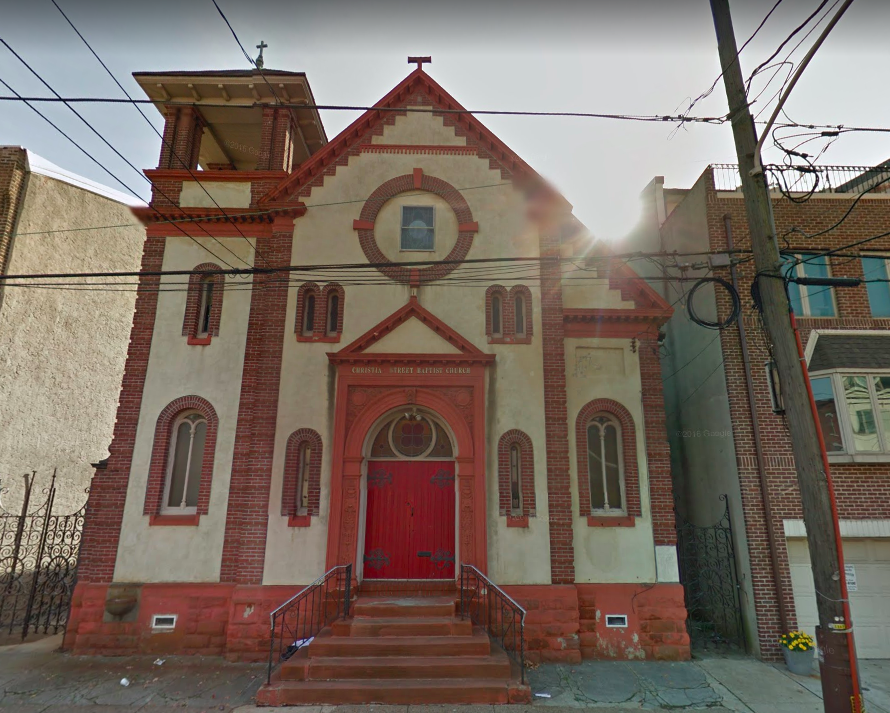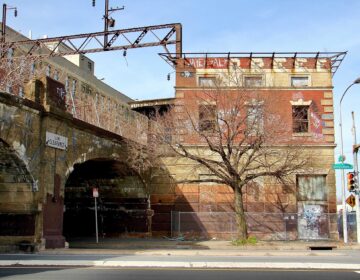Blocking Babylon: Historical Commission prevents demo of church properties in Bella Vista, Lawncrest

UPDATE: On Monday, November 20th, the Historical Commission announced a reversal on its vote to add Christian Street Baptist Church to the loal historic register, following notification that the Commission’s rules on voting were not followed properly. See here for more.
The drama reached new heights around two contentious preservation cases heard at November’s meeting of the Philadelphia Historical Commission.
Both involve shrinking congregations trying to divest themselves of older buildings they don’t have the funds to maintain. Both Christian Street Baptist Church in Bella Vista and Trinity Oxford Church in Lawncrest are looking to get rid of underused properties: the congregations need funding and the developers are eager to replace old buildings them with developments matching prevailing neighborhood trends (townhouses in Bella Vista; a gas station and convenience store in Lawncrest). Preservationists are contesting both, seeing each as just the latest examples of Philadelphia’s distinctive architectural history slipping away.
These Greek tragedies are becoming increasingly common as congregations across the city shrink and real estate values in many centrally located areas surge to historic highs. In some cases, like Fishtown’s St. Laurentius, the internecine neighborhood conflicts can drag on for years.
That may well happen in both of these cases. After a marathon, seven-hour Historical Commission meeting Friday, both churches were added to the local historic register, which makes it significantly harder for the buildings to be torn down for new developments. But both congregations may end up appealing, turning these neighborhood fights into courtroom dramas.
Christian Street Baptist, 1020-24 CHRISTIAN STREET
Last month, the Historical Commission held off on ruling on the nomination for the Christian Street Baptist Church, hoping the two sides could come to some agreement. But none has been forthcoming, forcing the commission to decide the Church’s fate. In the end, it added Christian Street Baptist to the historic register in a tight vote, over the protestations of the building’s would-be buyer and its congregation.
This small African-American congregation occupies a distinctive 126-year-old red sandstone church near the Italian Market, styled to match the red brick rowhomes that surround it. But despite its modest beauty, the building is in a bad state of disrepair.
This summer, Pastor Clayton Hicks put the building up for sale at $1.5 million. Local developer Ori Feibush made a bid for the building, planning to knock it down and build five or six townhomes in its place. But preservationist Oscar Beisert, with support from the Bella Vista Neighbors Association, then nominated the church to the local historic register in a last-second effort to prevent its demolition.
At the end of the last meeting, the commission kicked the can down the road in hopes that the two sides could come to a compromise. But Christian Street Baptist representatives told the Historical Commission they hadn’t tried to speak with Beisert since last month’s meeting.
“Nothing new has come out,” Pastor Hicks told PlanPhilly on Thursday. “Beisert reached out, but I haven’t been in touch with him again. In the meeting, he talked about working with other churches to find a sale. But with First African in South Philly, for example, he worked with them, but it still cut their price in half. It’s not a good look to work with him.”
Feibush did not attend October’s meeting, but he showed up this time. He previously told PlanPhilly, and Beisert, that the façade could perhaps be preserved. But, on Friday, Feibush told the Historical Commission that he no longer believed that to be the case. After reevaluating the property more critically with some engineers, Feibush found preserving even just the façade to be far too expensive.
“It’s not even just the six hundred grand in structural steel,” said Feibush on Thursday. “I don’t know how you’d then tie that into a row of townhomes. I don’t even know how you’d build homes there, you’d have to move everything in over the façade. It becomes such a logistical nightmare that just doesn’t work for five homes.”
Paul Steinke, executive director of the Preservation Alliance of Greater Philadelphia, said he believed the church could be saved and sold for a price that worked for the congregation, noting that the Taber Chapel on 17th and Fitzwater had sold for $1.65 million. In response, Feibush said he had offered $2 million more than the eventual sale price — Christian Street Baptist would lose a lot of money if their church was added to the local historic register.
Larry Weintraub, a preservation architect affiliated with the Bella Vista Neighbors Association, offered the most spirited argument for preserving the building. Weintraub argued that the problems besetting the church — mold and rot at the end of rafters and joists — were easily fixable.
“We will not build like this again,” said Weintraub. “We will not build monumental stone and timber buildings again, in any neighborhood. How many Italian Renaissance Revival country churches exist in Philadelphia in a rowhouse [setting]? If we lose these irreplaceable, high quality buildings we lose a part of our soul.”
Emotions ran high during the meeting, as Pastor Hicks pleaded with the commission to consider the future of his congregation. Hicks said his congregation wouldn’t survive without the proceeds from selling the building to Feibush.
Such considerations are technically outside the purview of the Historical Commission. It is their role to rule simply whether a building is historically significant or not. But, in reality, other concerns are given considerable weight. In this case, the commissioners were clearly torn between the plight of the congregation and the imperative to preserve a unique building.
In the end, the vote reflected the difficulty of the decision. The commission voted five-to-four to add the building to the local register.
Trinty Oxford, 6901 RISING SUN AVENUE
In the Lower Northeast’s Lawncrest neighborhood, the 300-year-old Trinity Oxford Church is attempting to rid itself of an ancillary, Colonial Revival-style, parish house. The building would be demolished and replaced with an enormous Royal Farms gas station and restaurant, a Baltimore-based chain known for it’s surprisingly good fried chicken. As with Christian Street Baptist, preservationists and neighbors have rallied to preserve the church building, and on Thursday they found support from the Historical Commission.
Trinity Oxford Church itself was one of the first building designated historic in the City of Philadelphia back in the 1950s. But the parish house, which lies to the west of the main structure, dates to the 1920s.
Oxford Trinity officials insisted they needed to sell the property to shore up the church’s shaky finances and ensure its survival.
“If the designation goes through, a real community asset will be in peril and so will the community’s enjoyment of its open space,” said Reverend Canon Shawn Wamsley, chief of staff to Bishop Daniel Gutiérrez of the Diocese of Pennsylvania. “If the real sacred asset, the church, is put into jeopardy the vestry will be forced to disband, the congregation will disperse, and the church will close.”
The Preservation Alliance and community members joined forces to seek historic designation soon after the Royal Farms deal went public. While their goals are aligned here, their motivations differ.
Neighbors were outraged by the proposal to replace the parish house and nearby fields with another gas station, tasty chicken or not. The intersection where the parish house stands already hosts two gas stations, and until recently the building contained a daycare and a branch of the Police Athletic League. Until the negotiations with Royal Farms began, a playing field between the host church and the parish building offered children some of the only green space in the neighborhood.
The case became a cause célèbre for many of the neighborhood’s politicians. State representative Jared Solomon is leading the charge, with support from his erstwhile primary opponent former representative Mark B. Cohen (who was just elected judge). U.S. Rep. Brendan Boyle also lent his support to the designation effort. The neighbors and politicians paired up with the Preservation Alliance to make the case for conserving the parish house.
Oxford Trinity came before the commission armed with a self-commissioned poll showing public support for their plan, a study by Econsult Solutions arguing the building can’t be reused, and represented by a high-powered lawyer, Ballard Spahr’s Neil Sklaroff.
The Econsult study asserts the building could not be easily converted into common, commercially-viable uses like housing, retail, or office space. According to the study, Oxford Trinity, with its 200 members, has only $407,000 in liquid assets. The congregation believes that their depleted coffers, which must support staff and repair of their main church structure, cannot be stretched to cover the parish house as well.
“The church pays the $30,000 – $36,000 annual operating cost from the church’s general fund,” the report reads. “If the Oxford Parish House were to be sold or leased to a third party, that expense would disappear. Further, revenue from the lease could diminish or eliminate the annual deficit.”
Again placed in the uncomfortable position of apparently deciding the fate of a struggling religious institution, the commission acted more decisively this time. They again ruled for the preservationists, this time unanimously.
“Business corridor development is what this will mean for the neighborhood,” said State Rep. Solomon. “This is a transformational placemaking opportunity to work together in a collaborative way to get great development while looking towards the future.”
WHYY is your source for fact-based, in-depth journalism and information. As a nonprofit organization, we rely on financial support from readers like you. Please give today.





